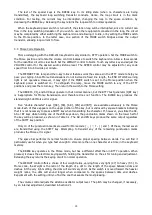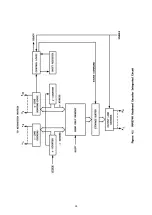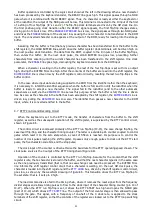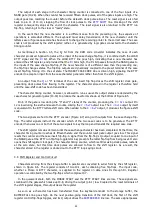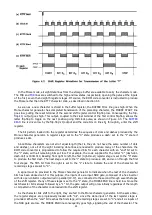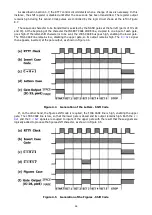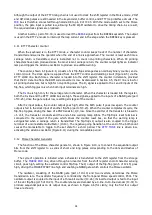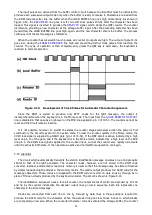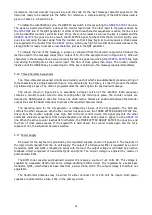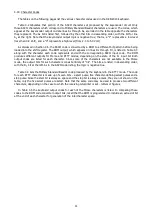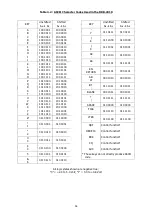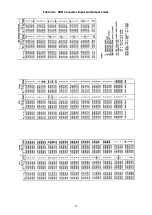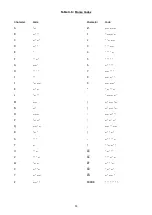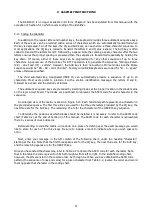
25
"end" bit is used by the Morse character generator to produce a space between characters, as explained in
Section 4.12.
In the RTTY mode, data bits are clocked out of the shift register at a constant rate, as all select pulses
are of the same duration, In Morse operation, however, the dashes are three times as long as the dots. The
register clock rate therefore depends on the code pattern. The clock pulse is supplied by the Morse
character generator rather than a fixed clock oscillator. The output of the character generator is inverted
and fed to the shift register clock bus via the
MORSE SHIFT
line. A shift occurs at the end of each dot or
dash, shifting the data bit for the next code pulse to the register output, from which it passes to the
character generator.
4.9 RTTY Encoder and Loop Interface
The serial output data bits from the shift register are coupled to both the RTTY encoder (Figure 8.7) and
the Morse character generator. With the keyboard in the RTTY mode, the Morse circuit is disabled and the
output bits activate only the RTTY loop keying circuitry.
The RTTY encoder accepts data inputs from three sources: the shift register output, the case character
generator, and the BREAK key circuit. Control inputs are received from the case change flip-flop, the case
insert flip-flop, and the M/R bus.
The Loop circuit is keyed by an NPN transistor, Q2, which is isolated from ground and the power supply
bus by a transformer in its base circuit. During mark pulses, the VHØ clock signal passes through a NAND
gate (IC-34) and an inverter (IC-24) to drive the emitter of a current source, transistor Q1. The pulses are
coupled through transformer T1 to a half-wave rectifier circuit, the output of which drives the keying
transistor into conduction. During space pulses, the VHØ clock signal is prevented from reaching the keying
circuit by a low level at pin 9 or 11 of IC-34.
During normal operation when a case change is not required, the gate is controlled by the output of the
shift register, which is applied to one input of a NAND gate (pin 9 of IC-33). With the case change circuitry
inactive, pin 11 of the gate is held high. The
M/R
bus is also high, holding pin 10 high. The shift register
signal therefore appears inverted at the gate output. When the register output is high the gate output is
low. This signal, fed to pin 11 of IC-34, cuts off the flow of VHØ clock pulses to the keying circuit and loop
current is prevented from flowing. Conversely, when the register output is low, the gate output is high and,
assuming that the BREAK line is low (BREAK key released), clock pulses flow and the keying transistor
conducts.
The BREAK key is provided to manually interrupt the loop circuit, When the keyswitch is closed, the
BREAK line is high. Fed to the input of a NAND gate (part of IC-55), it is combined with a signal from the
M/R
bus, which is high when the keyboard is in the RTTY mode. With the BREAK line high, the gate output
is forced low, preventing clock pulses from reaching the keying circuit. The loop current is therefore
interrupted until the key is released.
Summary of Contents for DKB-2010
Page 1: ......
Page 20: ...18...
Page 39: ...37 Table 4 3 ROM Converter Input and Output Codes...
Page 52: ...50 Figure 6 1 Logic Circuit Board Test Points...
Page 53: ...51 Figure 6 2 Keyswitch Circuit Board Test Points...
Page 54: ...52 Figure 6 3 Power Supply Circuit Board Test Points...
Page 57: ...55 Table 6 4 DKB 2010 Wire List...
Page 63: ...61...
Page 64: ...62...
Page 65: ...63...
Page 67: ...65...
Page 69: ...67...
Page 71: ...69...
Page 73: ...71...
Page 75: ...73...
Page 77: ...75...
Page 79: ...77...
Page 81: ...79...
Page 83: ...81...
Page 85: ...83...
Page 87: ...85...
Page 89: ...87...
Page 91: ...89...
Page 92: ...90...
Page 93: ...91...
Page 94: ...92...
Page 95: ...93...
Page 96: ...A1 EXTENDED MEMORY OPTION FOR THE DKB 2010 KEYBOARD INSTRUCTION MANUAL...
Page 100: ...A5...
Page 101: ...A6...





